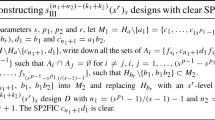Abstract
Split-plot designs have been widely used in industrial experiments. Up to now, most methods for choosing this kind of designs are based on the minimum aberration (MA) criterion. Recently, by introducing a new pattern, called aliased effect-number pattern (AENP), Zhang et al. proposed a general minimum lower-order confounding (denoted by GMC for short) criterion and established a general minimum confounding (also denoted by GMC for saving notations) theory. It is proved that, the GMC criterion selects optimal designs in a more elaborate manner than the existing ones, and when an experimenter has a prior about the importance ordering of factors in experiments the GMC designs are better than other optimal designs. In this paper we extend the GMC criterion to the split-plot design case and give a GMC-FFSP criterion for ranking split-plot designs. Some comparisons of the new criterion with the MA-MSA-FFSP criterion are given, and the optimal 32-run split-plot designs up to 14 factors under the two criteria are tabulated for comparison and application.
Similar content being viewed by others
References
Ai M Y, Zhang R C. Minimum secondary abberation fractional factorial split-plot designs in terms of consulting designs. Sci China Ser A, 2006, 49: 494–512
Bingham D, Sitter R R. Minimum aberration two-level fractional factorial split-plot designs. Technometrics, 1999, 41: 62–70
Bingham D, Sitter R R. Design issues in fractional factorial split-plot experiments. J Quality Technol, 2001, 33: 2–15
Bisgaard S. The design and analysis of 2k−p × 2q−r split-plot experiments. J Quality Technol, 2000, 32: 39–56
Box G E P, Jones S. Split-plot designs for robust product experimentation. Appl Statist, 1992, 19: 3–26
Cheng C S, Steinberg D M, Sun D X. Minimum aberration and model robustness for two-level factorial designs. J Roy Statist Soc Ser B, 1999, 61: 85–93
Cheng Y, Zhang R C. On construction of general minimum lower order confounding 2n−m designs with N/4 + 1 ⩽ n ⩽ 9N/32. J Statist Plan Inference, in press, 2010, doi: 10.1016/j.jspi.2010.02.006
Fries A, Hunter W G. Minimum aberration 2k−p designs. Technometrics, 1980, 22: 601–608
Goos P. Optimal versus orthogonal and equivalent-estimation design of blocked and split-plot experiments. Statist Neerlandica, 2006, 60: 361–378
Goos P, Vandebroek M. Optimal split-plot Designs. J Quality Technol, 2001, 33: 435–450
Goos P, Vandebroek M. D-optimal split-plot designs with given numbers and sizes of whole plots. Technometrics, 2003, 45: 235–245
Huang P, Chen D, Voelkel J. Minimum aberration two-level split-plot designs. Technometrics, 1998, 40: 314–326
Jones B, Goos P. D-optimal design of split-split-plot experiments. Biometrika, 2009, 96: 67–82
Li P F, Zhao S L, Zhang R C. A theory on constructing 2m−p designs with general minimum lower order confounding. Submitted to Statist Sinica, 2009
Mcleod R G. Optimal block sequences for blocked fractional factorial split-plot designs. J Statist Plan Inference, 2008, 138: 2563–2573
Mcleod R G, Brewster J F. The design of blocked fractional factorial split-plot experiments. Technometrics, 2004, 46: 135–146
Mcleod R G, Brewster J F. Blocked fractional factorial split-plot experiments for robust parameter design. J Quality Technol, 2006, 38: 267–279
Mukerjee R, Fang K T. Fractional factorial split-plot designs with minimum aberration and maximum estimation capacity. Statist Sinica, 2002, 12: 885–903
Mukerjee R, Wu C F J. A Modern Theory of Factorial Designs. Springer Series in Statistics. New York: Springer Science+Business Media Inc, 2006
Wu C F J, Hamada M S. Experiments: Planning, Analysis and Parameter Design Optimization. New York: Wiley, 2000
Yang J F, Li P F, Liu M Q, et al. \( 2^{(n_1 + n_2 ) - (k_1 + k_2 )} \) fractional factorial split-plot designs with clear effects. J Statist Plan Inference, 2006, 136: 4450–4458
Yang J F, Zhang R C, Liu M Q. Construction of fractional factorial split-plot designs with weak minimum aberration. Statist Prob Letters, 2007, 77: 1567–1573
Zhang R C, Cheng Y. General minimum lower order confounding designs: an overview and a construction theory. J Statist Plan Inference, 2010, 140: 1719–1730
Zhang R C, Li P, Zhao S L, et al. A general minimum lower-order confounding criterion for two-level regular designs. Statist Sinica, 2008, 18: 1689–1705
Zhang R C, Mukerjee R. Characterization of general minimum lower order confounding via complementary. Statist Sinica, 2009, 19: 363–375
Zhang R C, Mukerjee R. General minimum lower order confounding in block designs using complementary sets. Statist Sinica, 2009, 19: 1787–1802
Zhang R C, Park D K. Optimal blocking of two-level fractional factorial designs. J Statist Plan Inference, 2000, 91: 107–121
Zi X M, Zhang R C, Liu M Q. Bounds on the maximum numbers of clear two-factor interactions for \( 2^{(n_1 + n_2 ) - (k_1 + k_2 )} \) fractional factorial split-plot designs. Sci China Ser A, 2006, 49: 1816–1829
Author information
Authors and Affiliations
Corresponding author
Rights and permissions
About this article
Cite this article
Wei, J., Yang, J., Li, P. et al. Split-plot designs with general minimum lower-order confounding. Sci. China Math. 53, 939–952 (2010). https://doi.org/10.1007/s11425-010-0070-2
Received:
Accepted:
Published:
Issue Date:
DOI: https://doi.org/10.1007/s11425-010-0070-2




